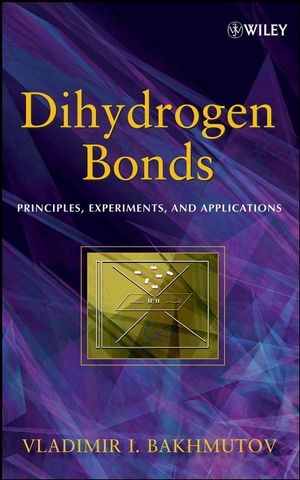Dihydrogen Bond: Principles, Experiments, and ApplicationsISBN: 978-0-470-18096-9
Hardcover
256 pages
March 2008
 |
||||||
I.2. References.
Chapter II. Brief summery on hydrogen-bonded systems: definitions and general view.
II.1. Conventional hydrogen bonds: the theoretical and experimental criteria of the hydrogen bond formation.
II.1.1. Energy and geometry of conventional hydrogen bonds.
II.1.2. Cooperative and anti-cooperative energy effects in systems with classical hydrogen bonds.
II.1.3. Dynamics of classical hydrogen bonds.
II. 2. Non-conventional hydrogen bonding a part of hydrogen-bonded systems: definition and classification.
II.3. Hydrogen bonds and chemical bonds: do they completely different.
II.4. Concluding remarks.
II.5. References.
Chapter III. Concept of dihydrogen bonding.
III.1. General view: from a H2 molecule to a dihydrogen bond via a dihydrogen ligand.
III.2. The nature of dihydrogen bonding: the topology of the electron density and contributions to the total bonding energy.
III.3. Scalar spin-spin coupling through dihydrogen bonds as an evidence for their partly covalent character.
III.4. Field effects on dihydrogen bonding.
III.5. Pressure effects on dihydrogen bonding.
III.6. The difference between hydrogen and dihydrogen bonds.
III.7. Concluding remarks.
III.8. References.
Chapter IV. How to find a dihydrogen bond: experimental criteria of the dihydrogen bond formation.
IY. 1. Dihydrogen-bonded complexes in the solid-state: the X-ray and neutron diffraction arguments.
IY. 1. 1. The topology of the electron density from the diffraction data.
IY. 2. The gas-phase experiments with dihydrogen-bonded complexes.
IY. 3. The experiments with dihydrogen-bonded complexes in solutions.
IY. 3. 1. The IR spectral criteria for the formation of dihydrogen-bonded complexes in solutions.
IY. 3. 2. How to determine the stoichiometry of dihydrogen-bonded complexes in solutions by the IR spectra.
IY. 3. 3. Energy parameters of dihydrogen-bonded complexes from the IR spectra in solutions: the room-temperature and variable-temperature IR experiments.
IY. 3. 4. The 1H nuclear magnetic resonance evidences for dihydrogen bonding in solutions.
IY. 3. 5. Energy parameters of dihydrogen bonds in solutions from the 1H NMR spectra.
IV.4. Concluding remarks.
IV. 5. References.
Chapter V. Intramolecular dihydrogen bonds: the theory and experiments.
V. 1. Weak intramolecular bonding C-H?H-C in systems with slightly polarized bonds.
V. 2. The intramolecular dihydrogen bonds in solid amino acids: bond C-H as weak proton acceptors.
V 3. Intramolecular dihydrogen bonds C-H?H-B.
V. 4. Intramolecular bonding N-H?H-B and O-H?H-B.
V. 5. Intramolecular dihydrogen bonds in metal hydride complexes.
V. 5. 1. Intramolecular dihydrogen binds in metal hydride clusters.
Y.6. Connection of intramolecular dihydrogen bonding with dehydrogenation reactions.
V.7. Concluding remarks.
V.8. References.
Chapter VI. Intermolecular dihydrogen-bonded complexes: from group 1A to group 4A and the xenon dihydrogen-bonded complexes.
YI.1. Group 1A: dihydrogen bonds X-H?H-Li and X-H?H-Na (X=F, Cl, NH3, CN, NC, HO, HS, ClCC, FCC, HCC).
YI.2. Bonding to hydrides of the elements in group 2A: dihydrogen X-H?H-Mg and X-H?H-Be (X=F, Cl, Br, NH3, NNN, CN, NC, ClCC, FCC, HCC, CH3CC, F2Be, FKr, FAr).
YI.3. Group 3A: dihydrogen bonds X-H?H-B, X-H?H-Al and X-H?H-Ga (X = FCC, HCC, LiCC, CH3OH, PriOH, CF3OH, CF3CH2OH, CFH2CH2OH, (CF3)2CHOH, (CF3)3COH, CN, CH3, Indole, imidazole, pyrrole, FKr, FAr).
YI.4. Hydrides of the elements of group 4A acting as proton acceptors and proton donors: very
weak dihydrogen bonds.
YI.4.1. Bonds C-H, Si-H and Ge-H in dihydrogen bonding.
YI.4.2. H-H Bonding.
VI.5. The xenon dihydrogen-bonded complexes.
VI.6. Concluding remarks.
VI.7. References.
Chapter VII. Intermolecular dihydrogen bonding in transition metal hydride complexes: bonds.
M-H?H-X (X = F, HO, CH3OH, PriOH, CF3OH, CF3CH2OH, CFH2CH2OH, (CF3)2CHOH,
(CF3)3COH, Indole, CF3COOH).
YII.1. Theoretical view on intermolecular dihydrogen bonding in transition metal hydride complexes.
YII.2. Energy and structural parameters of intermolecular dihydrogen-bonded complexes in solutions of transition metal hydrides.
YII.3. Unusual bonds M-H?H-M.
YII.4. Concluding remarks.
VII.5. References.
Chapter VIII. Correlation relationships for intermolecular dihdyrogen bonds.
YIII.1. The general classification of the negatively-polarized hydrogen atoms as proton accepting sites: basicity factors.
YIII. 2. Correlation relationships ?energy of the formation versus H?H distance? established for intermolecular dihydrogen bonds.
YIII. 3. Correlation relationships between energetic, structural and electron density parameters for intermolecular dihydrogen-bonded complexes.
VIII.4. Proton affinity of hydridic hydrogens.
VIII.5. Concluding remarks.
VIII.6. References.
Chapter IX. Perspectives of dihydrogen bonding in supramolecular chemistry and crystal engineering.
IX. 1. Concluding remarks.
IX.2 References.
Chapter X. Dihydrogen bonds as intermediates in intermolecular proton transfer reactions.
X.1. Methods applied in kinetic studies of proton transfer to hydridic hydrogens.
X.1.1. Electrochemical experiments.
X.1.2. Time-dependent IR spectra.
X.1.3. The NMR spectra.
X.1.4. Stopped-flow experiments.
X.1.5. Theoretical approaches.
X.2. Proton transfer to a hydridic hydrogen in the solid state.
X.3. Proton transfer to a hydride ligand in solutions of transition metal hydride complexes: theory and experiments.
X.3.1. Kinetic experiments with proton transfer to hydride ligands in solutions.
X.3.2. Proton/hydride exchanges as a measure of proton transfer to a hydride ligand in solutions.
X.3.3. Proton transfer to a hydride ligand in solutions: experimental observations of intermediates.
X.4. Energy profile of proton transfer to hydride ligands in solutions.
X.5. Energy, intermediates and transition states in intermolecular proton transfer to hydridic hydrogens: theoretical data.
X.5.1. Proton transfer to hydrides of the 3A elements.
X.5.2. The theory of proton transfer to transition metal hydrides.
X.6. Concluding remarks.
X.7. References.
XI. General conclusion.
XI.1. How short and long can the dihydrogen bonds be?
XI.2. Specific influence of the environment on dihydrogen bonding.
XI.3. References.
Subject Index.



